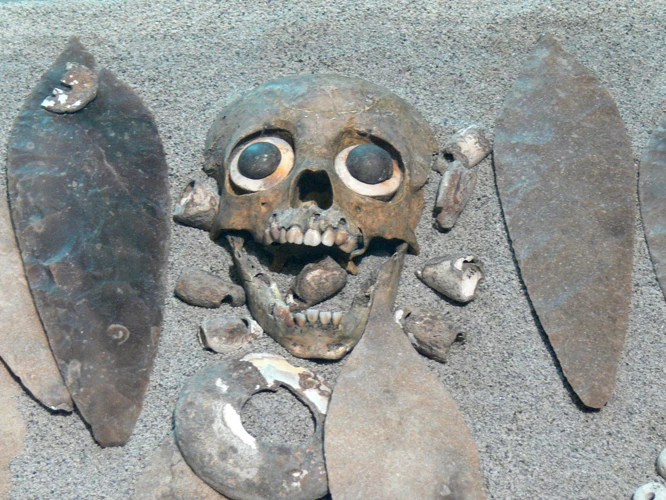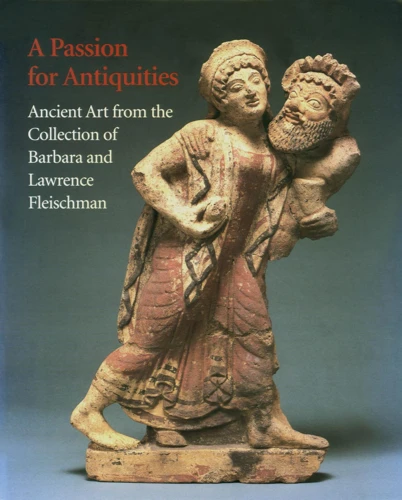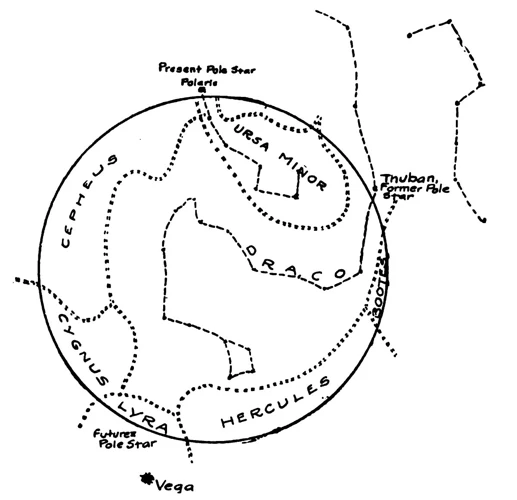In the vast and mysterious world of the Aztec Empire, the intricate web of trade and commerce served as the lifeblood of civilization. The Aztecs, with their advanced societal structure and vibrant economy, possessed a unique and fascinating system that allowed goods and services to flow throughout their empire. From bustling markets and skilled merchants to complex taxation and tribute systems, the Aztec economy was a complex tapestry of wealth, specialization, and diplomacy. Join us on a captivating journey as we delve into the depths of the Aztec Empire’s trade and commerce, exploring its economical system with awe and wonder.
Contents
- Aztec Society and Economy
- Markets and Merchants
- Taxation and Tribute
- Economic Specializations
- Role of Currency
- Market Regulations
- Trade Networks and Diplomacy
- Trade and Military Expansion
- Conclusion
-
Frequently Asked Questions
- 1. How did the Aztecs organize their markets?
- 2. What were the roles of Aztec merchants and traders?
- 3. What types of goods were traded in Aztec markets?
- 4. How did the tribute system work in the Aztec Empire?
- 5. Who collected taxes in the Aztec Empire?
- 6. What were the economic specializations in Aztec society?
- 7. Did the Aztecs have a currency system?
- 8. How did the Aztecs regulate their markets?
- 9. What were the major trade networks of the Aztec Empire?
- 10. How did the Aztec military expansion impact the economy?
- References
-
Frequently Asked Questions
- 1. How did trade and commerce function in the Aztec Empire?
- 2. What were the main goods traded in Aztec markets?
- 3. How were Aztec markets organized?
- 4. What was the role of merchants and traders in the Aztec Empire?
- 5. How did the tribute system work in the Aztec Empire?
- 6. What was the currency used in the Aztec Empire?
- 7. How did the Aztecs regulate their markets?
- 8. What were the major trade routes in the Aztec Empire?
- 9. How did military expansion impact the Aztec economy?
- 10. What was the economic significance of craftsmanship and artisans in the Aztec Empire?
- References
- Read More
Aztec Society and Economy

The Aztec Empire thrived on a complex and interconnected society and economy. At its core, the Aztec society consisted of a hierarchical structure, with the Emperor at the top, supported by nobles, warriors, priests, and commoners. This hierarchical structure played a pivotal role in the Aztec economy, as it determined the distribution of resources and wealth. The economy revolved around the concepts of self-sufficiency and reciprocity within each community, as well as tribute and taxation from conquered territories. The Aztecs were skilled agriculturalists, utilizing innovative techniques such as terraced farming to maximize crop yield. Craftsmanship and artisanal skills were also highly valued, with specialized artisans producing a wide range of goods, including textiles, ceramics, and jewelry. These goods were then traded in local markets, regional trade networks, and even long-distance trade routes. The currency system of the Aztecs was based on the use of cocoa beans, which were used for trade and as a form of taxation. Alongside the currency system, barter was also commonly practiced in Aztec markets. Despite the complexity of the Aztec economy, strict regulations and standards were in place to ensure fair trade and prevent fraud. The Aztec Empire’s economy played a vital role in sustaining its vast civilization, supporting its military expansion, and facilitating diplomatic relations with neighboring empires. So, let us now delve deeper into the fascinating intricacies of the Aztec society and economy.
Markets and Merchants

In the bustling world of the Aztec Empire, markets thrived as vibrant hubs of commerce and social interaction. These markets played a crucial role in the Aztec economy, serving as centers for trade and exchange of goods and services. The organization of Aztec markets was meticulous, with designated areas for different types of goods such as food, textiles, pottery, and more. These markets were a gathering place for people from all walks of life, from farmers and artisans to nobles and traders. Aztec merchants, known as pochteca, were highly skilled individuals who traversed various trade routes, both locally and regionally, to acquire goods for trade. The pochteca were organized into guilds and had their own hierarchy and regulations. They played a vital role in the economy, transporting goods, negotiating prices, and even acting as informants for the Aztec government. The goods traded in Aztec markets were diverse and included agricultural products, textiles, precious metals, featherwork, and even slaves. The markets also served as avenues for cultural exchange, where ideas, traditions, and even religious practices were shared. These bustling marketplaces were a testament to the economic vibrancy and societal complexity of the Aztec Empire.
1. Organization of Markets
The organization of markets was a fundamental aspect of the Aztec economy, providing a platform for trade and exchange of goods. Aztec markets were typically held in designated areas within cities and towns, often located near a central plaza or temple. These markets were bustling hubs of activity, attracting both local residents and merchants from neighboring areas. The organization of markets was overseen by appointed officials, known as pochteca, who played a crucial role in regulating and facilitating trade. The marketplaces were divided into different sections or zones, each specializing in specific types of goods. This division allowed for efficient trade and made it easier for buyers to find the products they desired. Buyers and sellers would gather in these designated sections, with vendors setting up stalls or display areas to showcase their merchandise. The marketplaces were lively and vibrant, with a wide array of goods available, including food, textiles, pottery, jewelry, and even slaves. The organization of markets fostered a sense of community and interaction, creating opportunities for socializing and networking. It was in these markets that the diverse cultures and traditions of the Aztec Empire converged, creating a truly dynamic and cosmopolitan atmosphere.
2. Aztec Merchants and Traders
Aztec merchants and traders played a crucial role in the economic prosperity of the empire. They were skilled individuals who traveled far and wide to acquire goods for trade. These merchants, known as pochteca in the Nahuatl language, were highly esteemed in Aztec society. They belonged to specialized merchant guilds and were granted privileges and protections by the government. Pochteca merchants were organized into groups, each with a leader who oversaw their activities. They ventured to distant lands, navigating treacherous terrains and forging trade connections. They used various modes of transportation, including foot, canoe, and even llamas, depending on the region being traveled. The pochteca had extensive knowledge of trade routes, market demand, and production centers, making them valuable sources of information. They would often journey for months at a time, exchanging Aztec goods such as textiles, pottery, obsidian, and feathers for exotic items like jade, turquoise, feathers, and precious metals. The pochteca also acted as spies, gathering information about lands they visited, which proved valuable for military and diplomatic purposes. These courageous merchants played a vital role in expanding the Aztec trade network, promoting cultural exchange, and bolstering the wealth of the empire. Their intricate knowledge of trade routes and their ability to negotiate and navigate foreign lands contributed significantly to the economic success of the Aztec civilization. Thus, the Aztec merchants and traders were truly the backbone of the empire’s bustling commerce.
3. Goods Traded in Aztec Markets
The Aztec markets were vibrant hubs of trade and exchange, bustling with a variety of goods that catered to the diverse needs and desires of the empire’s inhabitants. A wide range of commodities was traded in these markets, showcasing the richness and complexity of Aztec society. One of the most sought-after goods was agricultural produce such as maize, beans, squash, and chili peppers, which formed the staple diet of the Aztec population. These crops were cultivated through advanced farming techniques and played a crucial role in sustaining the empire’s food supply. Additionally, textiles and garments made from cotton and agave fibers were highly valued, showcasing the skill and artistry of Aztec weavers. Precious metals, including gold and silver, adorned jewelry and ceremonial objects, symbolizing wealth and status. Exquisite featherwork, crafted using vibrant feathers, created elaborate headdresses, cloaks, and other decorative pieces. Salt, essential for food preservation, was another vital commodity exchanged in Aztec markets. Other goods included obsidian tools and weapons, pottery, cocoa beans, exotic feathers, medicinal herbs, and even slaves. These diverse goods reflected the multifaceted nature of Aztec society and the extensive trade networks that connected various regions within the empire. The Aztec markets were truly a melting pot of culture and commerce, where goods from different regions were exchanged, and the wealth and diversity of the empire were on display. From the maize fields to the feather workshops, the Aztec markets thrived with a vast array of traded goods, shaping the economy and reflecting the complexities of Aztec society.
Taxation and Tribute

The Aztec Empire had a sophisticated system of taxation and tribute that played a crucial role in their economy. The tribute system involved the collection of goods, resources, and labor from conquered territories as a form of payment to the empire. Each province or city-state under Aztec rule was required to pay tribute in the form of agricultural products, textiles, precious metals, and even human sacrifices. Tribute collectors, known as “tlatocanqui,” were appointed to oversee the collections and ensure compliance. Additionally, taxation was imposed on various economic activities, including commercial transactions, land ownership, and artisan production. Tax collectors, known as “calpixque,” were responsible for collecting these taxes, which were often paid in the form of cocoa beans, the currency of the Aztec Empire. The collected tribute and taxes were then redistributed throughout the empire, ensuring the stability and prosperity of Aztec society. Through this intricate system of taxation and tribute, the Aztec Empire maintained its economic power and sustained the vast civilization it had built.
1. Tribute System
The tribute system was a crucial component of the Aztec economy, serving as a means of acquiring valuable resources and solidifying control over conquered territories. Tributes were essentially payments or offerings made by subject provinces to the Aztec Empire. These tributes could take various forms, including goods, labor, and even people. The collection of tributes was meticulously organized, with each province required to provide specific items based on their resources and capabilities. These tributes were then redistributed throughout the empire to fulfill various needs. The tribute system not only allowed the Aztecs to sustain their economy but also served as a means of social control and political dominance. It ensured the loyalty and submission of subject provinces while providing the empire with the necessary resources to support its population, military, and infrastructure. The tribute system was a testament to the sophisticated administrative structure of the Aztec Empire, where tribute collectors, known as calpixques, played a vital role in overseeing the collection and transportation of tributes. The intricate workings of the tribute system contributed to the economic stability and expansion of the Aztec Empire, making it a vital aspect of their society and economy.
2. Taxation and Tax Collectors
Taxation played a significant role in the Aztec economy, and it was the responsibility of tax collectors to ensure that the empire received its due contributions. These tax collectors, known as calpixques, were appointed by the state and held an important position in Aztec society. Their primary responsibility was to collect various forms of tribute, including goods, agricultural produce, and even human labor, from the conquered territories and subject communities. The collected tribute was then redistributed to support the empire’s administrative apparatus, temples, and the ruling elite. The calpixques employed a meticulous system for tax collection, which included detailed record-keeping and the use of standardized measures for accurate assessment. In addition to tribute collection, the tax collectors also played a role in monitoring market activities to prevent tax evasion. While they were responsible for upholding the taxation system, it is important to note that tax collectors themselves were not exempt from paying tribute to higher-ranking officials. This intricate web of taxation and tribute ensured a constant flow of resources to fuel the Aztec Empire’s economy and sustain its expansive infrastructure. The role of tax collectors in the Aztec society exemplifies the administrative and economic prowess of the empire, where taxation served as a crucial mechanism for maintaining order and supporting the empire’s growth.
3. Redistribution of Wealth
The Aztec Empire had a system in place for the redistribution of wealth, ensuring a certain level of social equity within their society. This was accomplished through several mechanisms implemented by the Aztec government. One such mechanism was the collection of tribute and taxation from conquered territories. The tribute collected, consisting of goods, resources, and even human labor, was then redistributed among different sectors of Aztec society. The Emperor held a significant portion of the wealth, which he used for various purposes, including the maintenance of the military and the support of religious institutions. Nobles and warriors also received a portion of the redistributed wealth, reinforcing their status and allowing them to maintain their social standing. Another aspect of wealth redistribution was through communal institutions such as temples and public works projects. The Aztec government allocated resources to these institutions, which in turn provided for the welfare of citizens and the funding of public infrastructure projects. The redistribution of wealth was essential for ensuring social stability and cohesion within the empire, as it provided for the basic needs of the population and reduced inequality. It was a carefully managed system that aimed to maintain harmony and prevent social unrest. With the redistribution of wealth, the Aztec Empire was able to balance socio-economic disparities and create a sense of shared prosperity among its people and communities. This equitable distribution of resources contributed to the overall well-being of the society and played a significant role in maintaining the stability of the empire.
Economic Specializations

Within the rich tapestry of the Aztec Empire’s economy, there existed a diverse range of economic specializations that fueled the prosperity and growth of the civilization. One such specialization was agriculture, with the Aztecs employing innovative techniques such as terraced farming to cultivate crops like corn, beans, and squash. These agricultural endeavors not only ensured a steady food supply but also created surpluses that could be traded and exchanged. Additionally, the Aztecs were renowned for their exceptional craftsmanship and artisanal skills. Skilled artisans worked diligently to create exquisite textiles, intricate ceramics, and stunning jewelry. These goods not only served as luxury items but were also crucial for trade and economic exchange. Trade routes, both local and long-distance, facilitated the flow of these specialized goods, enabling the Aztecs to engage in commerce with neighboring tribes and empires. The economic specializations of the Aztecs were therefore instrumental in their economic strength, cultural exchange, and overall prosperity, laying the groundwork for the empire’s remarkable economic system.
1. Agriculture and Terraced Farming
Agriculture played a crucial role in the Aztec Empire, and one of their remarkable agricultural practices was terraced farming. The Aztecs ingeniously transformed the steep slopes of the Mesoamerican landscape into fertile farming terraces, making the most efficient use of available land for cultivation. These terraces were constructed by cutting into hillsides and building stone walls to create flat areas for planting crops. Not only did terraced farming prevent soil erosion, but it also allowed for efficient irrigation and drainage systems. The Aztecs cultivated a variety of crops, including maize (corn), beans, squash, amaranth, and chilies, among others. Maize held particular importance in Aztec culture, serving as a staple food and playing a significant role in religious rituals. The Aztecs used sophisticated agricultural techniques such as crop rotation and agroforestry, which involved planting trees alongside crops to provide shade and improve soil fertility. This sustainable approach to agriculture ensured a steady supply of food for the growing population of the empire. The surplus agricultural produce was traded in local markets and used as tribute from conquered territories. The success of Aztec agriculture and the innovation of terraced farming were crucial in supporting the empire’s economy and providing sustenance to its people.
2. Craftsmanship and Artisans
Craftsmanship and artisans held a prominent position within the Aztec society, playing a crucial role in the economy and cultural expression. Skilled artisans, known as “tlacuilos,” dedicated their lives to perfecting their craft and producing exquisite goods that ranged from textiles to ceramics and intricate jewelry. These artisans were highly respected and sought after, as their work showcased the creativity, skill, and cultural identity of the Aztec civilization. Textiles were a particularly prized commodity, with skilled weavers creating intricate and vibrant fabrics using various materials such as cotton, agave fiber, and feathers. These textiles were not only used for clothing but also for various ceremonial and decorative purposes. Ceramic artisans, known as “tlacuilos de barro,” crafted a wide range of pottery, including plates, bowls, and figurines, often adorned with elaborate patterns and intricate designs. These pottery pieces were not only utilitarian but also served as decorative items and status symbols. Jewelry artisans, or “joaltomeh,” were highly skilled at crafting intricate pieces using gold, silver, precious stones, and colorful feathers. These jewelry items were worn by the elite as a sign of wealth and stature, displaying the opulence and power of the Aztec elites. Artisans were recognized for their expertise and were organized into guilds or “calpulli,” where knowledge and techniques were passed down through generations. The craftsmanship of these artisans played a significant role in both local and long-distance trade, with their goods being sought after by merchants and traders across the empire. The Aztec society’s appreciation for craftsmanship and the artistic skills of these artisans not only contributed to the economy but also enriched the cultural fabric of the empire, preserving its legacy through their exceptional creations. Their works of art continue to fascinate and mesmerize us today, reminding us of the rich and vibrant Aztec civilization with each delicate stroke and intricate design.
3. Trade Routes
Trade routes played a crucial role in the flourishing Aztec economy, facilitating the exchange of goods and ideas over vast distances. These routes connected different regions within the empire, as well as extended beyond the empire’s borders to neighboring empires and distant lands. The Aztecs had an intricate network of trade routes that allowed for the transportation of various commodities and resources. One notable trade route was the pochteca trade network, operated by a specialized class of merchants known as pochteca. These skilled traders ventured far and wide, navigating treacherous terrains and trading with distant regions, including areas such as Oaxaca, the Gulf Coast, and even as far as Central America. Along these routes, goods such as textiles, spices, obsidian, feathers, and precious metals were transported in large quantities. This extensive trade network not only contributed to the economic prosperity of the Aztec Empire but also fostered cultural exchanges and the spread of ideas. The trade routes were pathways that linked diverse communities and played a crucial role in the expansion and influence of the Aztec civilization. The intricate web of trade routes, with its bustling caravans and intrepid merchants, was a vital component of the Aztec’s interconnected and vibrant economy, which fueled the Empire’s growth and prosperity. So, let us now embark on a journey along these fascinating trade routes, exploring the rich tapestry of commerce and cultural exchange that shaped the Aztec Empire.
Role of Currency

The role of currency in the Aztec Empire was a fascinating aspect of their economic system. Cocoa beans were the primary form of currency among the Aztecs, and they served as a medium of exchange for goods and services. The value of cocoa beans varied based on their quality and size, with larger beans being worth more. This system allowed for trade to take place efficiently, as individuals could easily determine the value of goods using cocoa beans as a common benchmark. The use of cocoa beans as currency also extended to taxation, with tribute payments often consisting of cocoa beans. However, it’s important to note that the Aztecs also practiced a barter system alongside the use of cocoa beans. Bartering allowed for the exchange of goods without the involvement of currency. The innovative use of cocoa beans as currency played a vital role in facilitating trade and commerce within the Aztec Empire. (Reference: Role of Medicine Men and Women in Native American Mythology)
1. Cocoa Beans as Currency
Cocoa beans held a unique and prominent position in the Aztec economy as a form of currency. Known as “xocoatl,” cocoa beans were highly valued and widely used for trade among the Aztecs. The Aztec society recognized the versatility and desirability of cocoa beans, using them not only as a medium of exchange but also as a unit of measurement for pricing goods and services. The quality and size of the cocoa beans determined their value, with larger and more perfectly shaped beans holding greater worth. This system allowed for a standardized value of goods, making transactions more efficient and reliable.
Cocoa beans were especially significant in the tribute and taxation system of the Aztecs. Tribute payments from conquered territories were often measured and collected in the form of cocoa beans. The amount of cocoa beans received would reflect the level of wealth and resources of the conquered region. The beans would then be stored in vast warehouses to be later redistributed or used for trade purposes.
While cocoa beans were a valuable currency within the Aztec Empire, their use extended beyond economic transactions. Cocoa beans played a vital role in religious ceremonies, elite banquets, and even as a beverage enjoyed by the nobility. The traditional Aztec drink, referred to as “xocoatl” or “chocolatl,” was a mixture of ground cocoa beans, water, and various spices.
It’s important to note that the use of cocoa beans as a currency was not unique to the Aztecs. Other Mesoamerican civilizations, such as the Maya, also utilized cocoa beans as a form of currency. The widespread recognition and acceptance of cocoa beans speak to their cultural significance and value within these ancient societies.
Cocoa beans held great economic and cultural importance within the Aztec Empire. As a versatile and valuable commodity, they served as a medium of exchange, unit of measurement, and tribute payment. The use of cocoa beans as currency demonstrated the sophistication and complexity of the Aztec economy, where goods, services, and wealth flowed through their empire, symbolizing the fascinating intricacies of trade and commerce in the ancient world.
2. Barter System
The barter system was an integral part of the Aztec economy, serving as a method of exchange alongside the use of cocoa beans as currency. In this system, goods were traded directly between individuals or communities without the need for a standardized medium of exchange. Bartering allowed the Aztecs to acquire goods and resources that may not have been readily available within their own communities. The exchange process was based on a mutual agreement between the parties involved, with each party evaluating the value of the items being exchanged. The Aztecs had a wide range of goods that were commonly bartered, including agricultural products such as maize, beans, and squash, as well as textiles, ceramics, and precious metals. The barter system promoted social interactions and enabled the Aztecs to establish trade relationships with neighboring communities and regions. For example, communities specializing in the production of certain goods would trade with others to meet their specific needs. The barter system was flexible and adaptable, allowing the Aztecs to navigate economic transactions even in the absence of a standardized currency. It played a significant role in facilitating trade and contributing to the overall economic prosperity of the Aztec Empire.
3. Inflation and Price Control
In the realm of Aztec economics, inflation and price control played a significant role in ensuring stability within the marketplace. The Aztec Empire implemented various measures to prevent rampant inflation and maintain consistent price levels. The central authority closely monitored and regulated the production and distribution of goods. This control was exerted through a combination of strict market regulations, taxation policies, and the management of resources. The Aztecs recognized the potential negative consequences of unchecked inflation, such as devaluation of currency and economic instability. To counteract this, price controls were implemented to stabilize the cost of goods and services. This involved setting maximum prices for essential goods, allowing for affordability and accessibility to the general population. The central authority also intervened in the market to control the supply and demand dynamics. By carefully managing the circulation of goods and resources, the Aztecs were able to maintain a relatively stable economy. This emphasis on price control ensured that the benefits of trade and commerce were distributed equitably throughout the empire. It fostered an environment of trust and stability, allowing for sustained economic growth and prosperity. Through their astute understanding of economic principles, the Aztecs effectively managed inflation and price control to create a thriving marketplace within their empire.
Market Regulations

Market regulations were a crucial aspect of the Aztec Empire’s trade and commerce. The Aztecs implemented strict controls and standards to ensure fair and equitable trade within their markets. Weights, measures, and standards were established to maintain accuracy and prevent fraud. Merchants were required to adhere to these regulations, ensuring that both buyers and sellers had confidence in the transactions. The Aztecs implemented controls on luxury and exotic goods, which were often reserved for the nobility. By restricting the availability and distribution of these goods, the Aztecs maintained a sense of exclusivity and heightened their desirability. Market regulations were not only in place to maintain order and fairness but also reflected the hierarchical structure of Aztec society. These regulations helped preserve the economic stability of the empire while catering to the needs and preferences of different societal classes. Thus, the Aztec Empire’s market regulations played a pivotal role in shaping and maintaining its vibrant economy.
1. Weights, Measures, and Standards
When it came to trade and commerce in the Aztec Empire, maintaining consistent weights, measures, and standards was of utmost importance. The Empire established a precise system to ensure fairness and accuracy in commercial transactions. The Aztecs used various units of measurement for different types of goods. For example, length was measured using their own “tlalquahuitl” unit, which was equivalent to about 0.46 meters or 1.5 feet. For weight, they used a unit known as “tlacxitl” which was approximately 26 grams or 0.92 ounces. In order to standardize these measurements, the Aztecs created official scales and standardized units that were used across the empire. These scales were made of wood or stone and were often adorned with intricate carvings and designs. Merchants and traders were required to use these guild-approved scales to measure their goods accurately. Additionally, the Aztecs developed regulations regarding the quality and authenticity of goods traded. They employed inspectors who would examine merchandise to ensure its quality, purity, and conformity to established standards. This meticulous attention to weights, measures, and standards fostered trust and fairness in trade transactions within the Aztec Empire.
Source: “Mars: The Warrior Planet Impact on Motivation and Action in Astrology”
2. Controls on Luxury and Exotic Goods
Controls on luxury and exotic goods were an integral part of the Aztec trade and commerce system. The Aztec government implemented strict regulations to oversee the production, distribution, and consumption of these highly sought-after items. One of the primary mechanisms for controlling luxury and exotic goods was through the use of sumptuary laws. These laws dictated who could possess and display certain luxurious items based on their social status. For example, only members of the elite class were allowed to wear jade, feathers, or precious metals. In addition to sumptuary laws, the Aztec government also imposed taxes and tariffs on luxury and exotic goods. This ensured that the consumption of such items was limited to the wealthy and privileged, while also generating revenue for the empire. The Aztecs also tightly controlled the sourcing and trade of exotic goods, such as precious stones, tropical fruits, and rare animal products. They established trade routes and diplomatic relations with neighboring empires to acquire these goods, often through tribute or exchange. The control over these goods not only demonstrated the wealth and power of the Aztec elite but also served as a means of maintaining social order and stability within the empire. Through their stringent controls on luxury and exotic goods, the Aztec government maintained a firm grip on the economy while reinforcing the social hierarchy and status symbols of their society.
3. Market Regulations and Laws
Market regulations and laws played a crucial role in maintaining order and fairness within the Aztec trading system. The Aztec Empire had a well-defined set of regulations enforced by the government to ensure that markets functioned smoothly. Traders and merchants had to adhere to specific standards and guidelines to engage in commerce. One such regulation was the establishment of standardized weights, measures, and standards. This ensured consistency in trade and prevented manipulation or fraud. Additionally, luxury and exotic goods were subject to strict controls. The distribution and availability of these goods were carefully monitored by the authorities to maintain social harmony and prevent excessive accumulation of wealth. Market regulations also extended to the pricing of goods, with authorities implementing price controls to prevent inflation and ensure fair trade. Violations of these market regulations would result in penalties or fines, highlighting the strict enforcement of the law. By implementing these regulations and laws, the Aztecs aimed to maintain a balanced and orderly trading system that benefited both merchants and consumers alike.
Trade Networks and Diplomacy

Trade networks and diplomacy played a crucial role in the Aztec Empire, connecting the vast territories and facilitating the exchange of goods and ideas. At the local and regional level, trade routes were established, allowing for the flow of goods between different communities. These trade networks were facilitated by both land and water routes, with merchants transporting their wares by foot, canoe, or even on specialized trading vessels. The Aztecs engaged in long-distance trade as well, establishing connections with distant civilizations such as the Maya and the Mixtec. These long-distance trade routes were arduous and required careful navigation through treacherous terrains. Diplomatic ties were also forged through trade, as ambassadors would accompany the merchants to promote peaceful relations and establish alliances. These diplomatic efforts were essential for maintaining stability and expanding their influence. The strong trade and diplomacy networks of the Aztec Empire contributed to its economic prosperity and cultural exchange, solidifying its position as a thriving civilization.
1. Local and Regional Trade Networks
1. Local and Regional Trade Networks:
Local and regional trade networks were essential components of the Aztec economy, facilitating the exchange of goods and services within and between communities. These networks served as vital arteries, connecting different regions and promoting economic growth and cultural exchange. In the city of Tenochtitlan, the capital of the Aztec Empire, there was a vast market known as the Tlatelolco market. This bustling marketplace was the epicenter of commerce, attracting traders from all over the empire. Goods such as food, textiles, pottery, and agricultural products were brought to the market and exchanged for other commodities.
The trade networks extended beyond the city of Tenochtitlan, spreading across the empire. Each region had its own distinct specialties and resources, which encouraged trade between communities. Coastal regions, for example, had access to marine resources like fish and salt, which were highly sought after by inland communities. These goods were transported through a system of trade routes and canals, allowing for efficient distribution.
To facilitate trade, the Aztecs established market days called “tianquiztli,” where communities would gather and engage in buying and selling activities. These market days were highly regulated, with designated spaces for different types of goods and goods separated based on their value and complexity. Traders would set up stalls or blankets and display their products while engaging in bartering or using the cocoa bean currency for transactions.
Trading was not limited to goods alone but also included the exchange of information, ideas, and cultural practices. Through these trade networks, the Aztecs were exposed to new technologies, artistic influences, and agricultural techniques. This cultural exchange played a crucial role in shaping the vibrant and diverse society of the Aztec Empire.
Local and regional trade networks were the arteries that pumped life into the Aztec economy. They connected communities, facilitated the exchange of goods, and stimulated cultural exchange. The Tlatelolco market and its various market days served as vibrant hubs of economic activity, while the extensive trade routes and canals allowed for the efficient distribution of goods across the empire. These networks were not only crucial for sustaining the economy but also contributed to the growth and development of Aztec society as a whole.
2. Long-Distance Trade Routes
Long-distance trade routes played a crucial role in the Aztec Empire’s economy, facilitating the exchange of goods and ideas with distant regions. The Aztecs were skilled navigators, utilizing various means of transportation including canoes and footpaths to navigate the diverse landscapes of Mesoamerica. One of the most prominent long-distance trade routes was the “Path of Tlaloc,” which connected the Aztec heartland with the Gulf Coast region. This route allowed for the transportation of luxury goods such as jade, obsidian, feathers, and textiles. Another significant trade route was the “Path of Quetzalcoatl,” which extended towards the south, reaching as far as the Maya civilization. Along this route, precious goods such as cacao, exotic animal furs, and tropical fruits were traded. The “Path of Tlaloc” and the “Path of Quetzalcoatl” were just a small part of the extensive trade network that connected the Aztecs with neighboring empires, such as the Mixtec, Zapotec, and Maya. These long-distance trade routes not only facilitated commerce but also served as conduits for cultural exchange and the spread of ideas. The Aztec Empire’s engagement in long-distance trade was a testament to their economic prowess and their desire for connections beyond their immediate borders.
3. Trade and Diplomacy with Neighboring Empires
Trade and diplomacy with neighboring empires played a crucial role in the economic prosperity of the Aztec Empire. The Aztecs engaged in extensive trade networks with regions such as the Gulf Coast, Oaxaca, and the Maya territories. These trade relationships allowed the Aztecs to acquire coveted goods such as jade, obsidian, feathers, and precious metals, which were highly valued within their society. Through extensive diplomatic efforts, the Aztecs established alliances and maintained peaceful relations with neighboring empires, ensuring the smooth flow of trade. The empire’s wealth and influence enabled the Aztecs to act as middlemen, facilitating trade between different regions. As a result, the Aztecs had control over the distribution and exchange of goods, further strengthening their economic position. Additionally, trade served as a means to solidify political alliances and maintain stability within the empire. Through the exchange of goods and resources, the Aztecs fostered diplomatic relationships, ensuring mutual respect and cooperation. Trade and diplomacy with neighboring empires were vital components of the Aztec economy, expanding their access to resources, fostering cultural exchange, and ultimately contributing to the overall prosperity of the empire.
Trade and Military Expansion

Trade and military expansion were closely interconnected in the Aztec Empire, shaping its economy and acquisition of valuable resources. The Aztecs engaged in conquests and military campaigns to expand their empire, which allowed them to gain control over territories, resources, and trade routes. Through their military conquests, the Aztecs imposed tribute demands on the conquered regions, ensuring a steady flow of goods and commodities into their empire. This tribute system enabled the Aztecs to accumulate wealth and resources from various regions, further fueling the economy. Additionally, the Aztecs engaged in the slave trade, acquiring captives from conquered territories and utilizing them for labor-intensive tasks, such as mining, agriculture, and construction. These slaves became vital contributors to the economy, helping sustain the empire’s economic growth and development. Military expansion allowed the Aztecs to establish control over trade routes and establish diplomatic relations with neighboring empires. This enabled the exchange of goods and facilitated regional and long-distance trade networks, contributing to a flourishing economy and cultural exchange. The symbiotic relationship between trade and military expansion in the Aztec Empire played a crucial role in its economic prosperity and dominance in the Mesoamerican region.
1. Tribute and Trade from Conquered Territories
Tribute and trade from conquered territories formed a significant aspect of the Aztec Empire’s economic system. When the Aztecs conquered new territories, they would impose a tribute system on the conquered peoples. This tribute was collected in various forms, including goods, crops, precious metals, and even slaves. These tributes were then redistributed throughout the empire, serving as a means of wealth accumulation for the ruling elite. The tribute also played a role in sustaining the empire’s economy, ensuring a steady supply of resources and commodities.
In addition to tribute, trade with conquered territories was another vital aspect of the Aztec economy. Through trade, the Aztecs acquired valuable commodities and resources that were not available within their own empire. This trade allowed for the exchange of goods such as exotic feathers, precious stones, textiles, and luxury items. The Aztec merchants and traders played a crucial role in facilitating this trade, traveling vast distances to establish trade networks and foster diplomatic relations with neighboring regions.
To manage the flow of tribute and trade, the Aztecs developed a bureaucratic system that included tax collectors and administrators. These officials oversaw the collection of tribute and ensured that trade was conducted within the regulations set by the empire. Tribute and trade from conquered territories played a significant role in sustaining the Aztec economy, fueling its expansion and enriching its ruling class.
1. Tribute and Trade from Conquered Territories:
Tribute and trade from conquered territories formed a significant aspect of the Aztec Empire’s economic system. When the Aztecs conquered new territories, they would impose a tribute system on the conquered peoples. This tribute was collected in various forms, including goods, crops, precious metals, and even slaves. These tributes were then redistributed throughout the empire, serving as a means of wealth accumulation for the ruling elite. The tribute also played a role in sustaining the empire’s economy, ensuring a steady supply of resources and commodities.
In addition to tribute, trade with conquered territories was another vital aspect of the Aztec economy. Through trade, the Aztecs acquired valuable commodities and resources that were not available within their own empire. This trade allowed for the exchange of goods such as exotic feathers, precious stones, textiles, and luxury items. The Aztec merchants and traders played a crucial role in facilitating this trade, traveling vast distances to establish trade networks and foster diplomatic relations with neighboring regions.
To manage the flow of tribute and trade, the Aztecs developed a bureaucratic system that included tax collectors and administrators. These officials oversaw the collection of tribute and ensured that trade was conducted within the regulations set by the empire. Tribute and trade from conquered territories played a significant role in sustaining the Aztec economy, fueling its expansion and enriching its ruling class.
2. Slave Trade and Acquisition of Commodities
2. Slave Trade and Acquisition of Commodities:
The Aztec Empire relied heavily on the acquisition of commodities, including valuable resources and goods, to sustain its economy and satisfy the demands of its growing population. One significant aspect of this acquisition was the slave trade. Slavery played a dual role in the Aztec society and economy. On one hand, slaves were treated as commodities themselves, bought and sold in markets or acquired through warfare. Slaves were often used to perform labor-intensive tasks, such as working in fields, mines, or households. They were also used as sacrificial victims in religious rituals. On the other hand, slaves were a means to obtain other commodities. Through the capture and enslavement of individuals from neighboring territories, the Aztecs acquired goods that were not available in their own region. This included luxury items, exotic goods, and resources like precious metals, gemstones, and rare feathers. Slavery served as a mechanism for the acquisition of both labor and commodities, contributing to the economic growth and expansion of the Aztec Empire.
To emphasize the significance of this trade, it is essential to highlight some key points:
- Slaves were bought and sold as commodities in Aztec markets.
- They were acquired through warfare and conquest.
- Slaves performed various tasks, including agricultural labor, mining, and domestic work.
- Slaves were also used as sacrificial victims in religious rituals.
- The acquisition of slaves provided the Aztecs access to valuable commodities not found within their own region.
- These commodities included luxury items, exotic goods, precious metals, gemstones, and rare feathers.
The slave trade and the acquisition of commodities played a significant role in the growth and prosperity of the Aztec Empire. The economy relied on the availability of these resources for trade, tribute, and as foundations of their craftsmanship and artistic pursuits.
3. Impact of Military Expansion on Economy
The military expansion of the Aztec Empire had a profound impact on its economy. As the Aztecs conquered new territories, they gained access to valuable resources, commodities, and tribute from the conquered peoples. This influx of wealth and resources fueled the Aztec economy and allowed for increased trade and economic growth. The Aztecs used their military might to establish control over key trade routes, enabling the flow of goods and facilitating trade with neighboring regions. They also engaged in the slave trade, where captured individuals were often used as laborers or sacrificial offerings, further contributing to the economy. The acquisition of new territories also led to an expansion in agricultural production, as the conquered lands were incorporated into the existing agricultural system. This allowed for an increased food supply, supporting the growing population and sustaining the Aztec empire. Additionally, the military conquests brought about an exchange of cultural practices, ideas, and technologies, further enriching the Aztec society and economy. However, it is worth noting that the constant state of warfare and military expansion placed a burden on the Aztec civilization, requiring significant resources and manpower. Nonetheless, the impact of military expansion on the Aztec economy cannot be understated, as it played a crucial role in shaping the empire’s economic landscape and shaping its status as a dominant force in Mesoamerica.
Conclusion

In conclusion, the trade and commerce system of the Aztec Empire was a vibrant and essential aspect of their society and economy. The Aztecs maintained a complex network of markets, where skilled merchants facilitated the exchange of goods and services. Tribute and taxation played a significant role in generating wealth and resources for the empire, which were then redistributed to support the needs of the society. Economic specialization was crucial, with agriculture and terraced farming ensuring food production, and craftsmanship and artisans contributing to the creation of a wide range of goods. The use of cocoa beans as currency and the practice of barter were integral to the economic transactions of the Aztecs. Market regulations were established to ensure fair trade and maintain standards. Additionally, the Aztecs engaged in local, regional, and long-distance trade networks, which not only facilitated economic growth but also enabled diplomatic relations with neighboring empires. The trade and commerce system played a pivotal role in supporting the military expansion of the empire, as tribute and trade from conquered territories fueled its economic strength. Overall, the Aztec society and economy intertwined seamlessly, creating a flourishing civilization that left a lasting impact on history.
Frequently Asked Questions

1. How did the Aztecs organize their markets?
The Aztecs organized their markets in a centralized manner. Each major city had its own market, called a “tianquiztli,” where vendors gathered to sell their goods. These markets were carefully divided into sections based on the type of goods being sold, ensuring efficient trade and easy navigation for shoppers.
2. What were the roles of Aztec merchants and traders?
Aztec merchants and traders played a crucial role in the empire’s economy. They traveled long distances, forging trade networks and establishing diplomatic relations with neighboring regions. They were responsible for bringing in exotic goods, facilitating the exchange of goods, and contributing to cultural diffusion throughout the empire.
3. What types of goods were traded in Aztec markets?
Aztec markets were bustling hubs where a wide variety of goods were traded. Common items included foodstuffs like maize, beans, and chili peppers, as well as textiles, pottery, jewelry, and even artwork. Precious metals such as gold and silver were also traded for their intrinsic value.
4. How did the tribute system work in the Aztec Empire?
The tribute system in the Aztec Empire was a method of taxation and wealth redistribution. Conquered territories were required to pay tribute, usually in the form of goods or labor, to the Aztec government. This system helped support the economy and ensure the flow of resources throughout the empire.
5. Who collected taxes in the Aztec Empire?
Tax collectors, known as “calpixque,” were responsible for collecting taxes in the Aztec Empire. They would visit villages and towns to assess the wealth and resources, determining the amount of tribute owed. These tax collectors played a vital role in the empire’s economic administration.
6. What were the economic specializations in Aztec society?
Aztec society had various economic specializations. Agriculture and terraced farming were essential for sustenance, while artisans and craftsmen produced goods of exceptional quality. Trade routes, both local and long-distance, were vital for the exchange of goods and fostering economic growth.
7. Did the Aztecs have a currency system?
Yes, the Aztecs had a currency system based on the use of cocoa beans, known as “cacao.” These beans were used as a medium of exchange for trade, and their value varied based on their quality. Cocoa beans were also used for taxation, with tribute payments often consisting of a certain number of beans.
8. How did the Aztecs regulate their markets?
Market regulations were an important aspect of the Aztec economic system. The empire had precise standards for weights and measures, ensuring fair trade and preventing fraud. Controls were also placed on luxury and exotic goods, sometimes restricting access to these items based on social status or rank.
9. What were the major trade networks of the Aztec Empire?
The Aztec Empire had a vast network of local and regional trade routes, connecting different cities and communities within the empire. Additionally, long-distance trade routes allowed for contact and trade with neighboring regions, such as the Maya civilization and the coastal areas of present-day Mexico.
10. How did the Aztec military expansion impact the economy?
The Aztec military expansion had a significant impact on the economy. Conquered territories were required to pay tribute, which enriched the empire and redistributed wealth. The acquisition of commodities and slaves through military campaigns also contributed to the growth of the economy, fueling trade and cultural exchange.
References
Frequently Asked Questions

1. How did trade and commerce function in the Aztec Empire?
Trade and commerce in the Aztec Empire were essential for the economy. They had organized markets, a system of taxation and tribute, economic specializations, and trade networks with neighboring empires.
2. What were the main goods traded in Aztec markets?
A variety of goods were traded in Aztec markets, including agricultural products, such as maize, beans, and squash, as well as exotic goods like feathers, jade, gold, and silver. Luxury goods like textiles, pottery, and obsidian tools were also popular.
3. How were Aztec markets organized?
Aztec markets were organized in a hierarchical manner, with specialized areas for different types of goods. There were specific sections for food, textiles, luxury goods, and even a separate area for slaves. Each market had designated days for specific types of products.
4. What was the role of merchants and traders in the Aztec Empire?
Merchants and traders played a crucial role in the Aztec Empire. They traveled long distances to bring goods from different regions. They were highly respected and had their own guilds. They were responsible for the distribution of goods and played a vital role in economic growth.
5. How did the tribute system work in the Aztec Empire?
The tribute system in the Aztec Empire involved the collection of goods and resources from conquered territories. These tributes were then redistributed among the ruling class and used to support the empire’s economy and maintain their military power.
6. What was the currency used in the Aztec Empire?
The primary currency used in the Aztec Empire was the cocoa bean. It was used for trading and as a medium of exchange. The beans were carefully counted and could be used for purchasing goods or as a form of tribute.
7. How did the Aztecs regulate their markets?
The Aztecs had regulations and laws to maintain fair trade practices. They had standards for weights and measures to ensure accurate transactions. Luxury and exotic goods were controlled to maintain their scarcity and value.
8. What were the major trade routes in the Aztec Empire?
The Aztecs had established local and regional trade networks that facilitated the exchange of goods within the empire. They also had long-distance trade routes that connected them with other civilizations, such as the Maya, the Toltecs, and even as far as the southwestern United States.
9. How did military expansion impact the Aztec economy?
Military expansion played a significant role in the Aztec economy. The empire acquired resources, commodities, and slaves through conquest, which increased their wealth and power. Tribute and trade from conquered territories also contributed to economic growth.
10. What was the economic significance of craftsmanship and artisans in the Aztec Empire?
Craftsmanship and artisans had a high economic significance in the Aztec Empire. They produced exquisite goods such as textiles, pottery, jewelry, and obsidian tools. The skills of the artisans were highly valued, and their products were traded within the empire and across trade networks.







